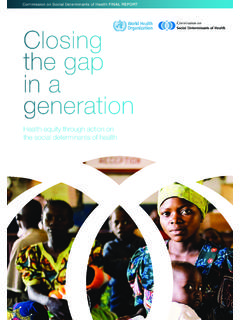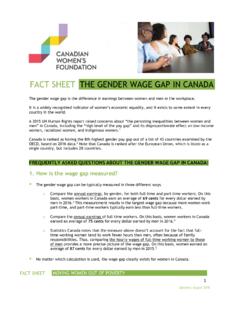Transcription of Fiscal policy - National Treasury
1 273 Fiscal policy In brief Fiscal policy is focused on containing the budget deficit and slowing the pace of debt accumulation to maintain spending programmes and promote confidence in the economy. The 2017 Budget tax proposals will raise R28 billion in additional revenue in 2017/18. Expenditure ceiling reductions amount to R10 billion in 2017/18 and R16 billion in 2018 /19. Despite revenue underperformance, the main budget primary deficit a key measure of Fiscal sustainability will halve from 1 per cent of GDP in 2015 /16 to per cent of GDP by the end of 2016/17. Net debt is forecast to stabilise at per cent of GDP in 2020/21. To address elevated Fiscal risks, government is managing the National and provincial wage bill, improving budget execution and stabilising the operations of financially troubled public entities.
2 Overview overnment is committed to a measured path of Fiscal consolidation that contains the budget deficit and stabilises public debt. The spending ceiling remains in place and previously announced tax measures are being implemented. Headcount in the public service has levelled out, relieving some of the upward pressure on the wage bill. Government s Fiscal stance takes account of risks associated with the macroeconomic outlook, budget execution and the finances of some state-owned companies. As a result of these measures, the main budget primary deficit has narrowed consistently over the past four years, despite slowing economic growth.
3 As a share of GDP, the primary deficit halves in the current year, and will move into surplus over the medium term. Achieving a primary surplus is a key milestone on the path to debt stabilisation. In addition, the share of total spending financed by government borrowing continues to decline. GFiscal policy focused on containing budget deficit and stabilising public debt 2017 BUDGET REVIEW 28 Nevertheless, significant risks remain. Economic growth is forecast to increase moderately off a very low base, and tax revenue projections have been revised downwards since the 2016 Medium Term Budget policy Statement (MTBPS). The wage bill continues to place upward pressure on the expenditure ceiling, and the financial position of state-owned companies has deteriorated.
4 A measured approach that protects the public finances and creates an enabling environment for faster economic growth is required over the medium term. The 2017 Budget proposals will: Reduce the expenditure ceiling by R10 billion in 2017/18 and R16 billion in 2018 /19. This will be achieved through reduced National department operating budgets; lower transfers to entities, provinces and local government; and reallocations. Chapter 5 discusses adjustments to government s spending plans. Introduce tax policy measures to generate an additional R28 billion in revenue in 2017/18, mainly through higher personal income taxes and fuel levies.
5 Chapter 4 discusses tax policy . Proposals to raise R15 billion in 2018 /19 will be announced in the 2018 Budget. The combination of a lower expenditure ceiling and higher taxes will narrow the consolidated budget deficit from an estimated per cent of GDP in 2016/17 to per cent by 2019/20. South Africa s development objectives, expressed in the National Development Plan, rely on achieving higher economic growth and using public resources effectively. If low growth were to persist, however, government would have to adjust its spending plans, and determine which policies to implement, downsize or delay. Securing Fiscal sustainability The central Fiscal policy objective is to stabilise the National debt-to-GDP ratio by closing the budget deficit.
6 Acting too quickly to reduce the budget deficit could hamper service delivery, delay economic recovery, and compromise tax revenue collection. But significant slippage against Fiscal targets is likely to result in credit rating downgrades, interest rate hikes and capital flight. If the latter scenario were to materialise, maintaining current levels of service delivery would be difficult and likely require extensive austerity measures. Table Consolidated Fiscal framework2013/142014/152015/162016/17201 7/182018/192019/20R billion/percentage of GDPO utcomeRevised estimate Medium-term estimates Revenue1 1 1 1 1 1 1 1 1 1 1 1 1 expenditure1 1 1 1 1 1 1 balance : National TreasuryTax revenue projections have been revised downwards since 2016 MTBPS Consolidated budget deficit projected to narrow to per cent by 2019/20 Significant slippage against Fiscal targets would likely result in rating downgrades CHAPTER 3.
7 Fiscal policy 29 The economic growth outlook remains largely unchanged since the 2016 MTBPS, but declining tax buoyancy is expected to result in lower tax revenue over the medium term. In total, revenue collection for the current year is projected to be R30 billion below the 2016 Budget estimate. Underspending and higher non-tax revenue should partially offset this shortfall, but government will have to borrow more to bridge the gap . The main budget net borrowing requirement will increase by a total of R43 billion between 2016/17 and 2018 /19 compared with the 2016 Budget projection. The borrowing requirement is discussed in Chapter 7.
8 As Table shows, consolidation measures have been applied both to revenue and expenditure since the 2015 Budget. The total revenue increase of R28 billion in 2017/18 is the result of tax measures announced in both the 2016 Budget and the MTBPS. Government has adhered to the spending ceiling since it was established in 2012, as shown in Table Spending plans allow for moderate real expenditure growth, with priority given to higher education, health and social development. The government wage bill will stabilise as a share of the budget, largely as a result of measures to reduce appointments in non-critical posts. Total main budget non-interest expenditure is projected to remain stable at per cent of GDP over the medium term.
9 Tax revenue will increase from 26 per cent of GDP in the current year to per cent of GDP in 2019/20. Table Macroeconomic performance and projections2013/142014/152015/162016/172 017/182018/192019/20 Percentage change ActualEstimateForecastReal GDP Nominal GDP CPI GDP at current prices (R billion)3 624 3 863 4 087 4 410 4 741 5 129 5 546 Source: National TreasuryTable Consolidation measuresR billion2015/16 2016/17 2017/18 2018 /192015 Budget Review Expenditure reductions10 15 Revenue increases17 2016 Budget Review Expenditure reductions 10 15 Revenue increases 18 15 15 2017 Budget Review Expenditure reductions 10 16 Revenue increases 13 Source.
10 National TreasuryOwing to revenue under-collection and declining tax buoyancy, government will have to borrow more Moderate real expenditure growth, with priority given to higher education, health and social development 2017 BUDGET REVIEW 30 The 2016 Budget projected that net debt (gross debt less government s cash balances) would stabilise in 2017/18 at per cent. Net debt is now forecast to stabilise at per cent of GDP in 2020/21. The revised projection reflects two factors: revenue shortfalls and the build-up of cash reserves for large debt redemptions over the period ahead. Figure Main budget revenue and non-interest spending1 1 Excludes financial transactions Source: National Treasury Figure Gross and net debt outlook Source: National Treasury and Reserve Bank Strengthening budget execution Consolidation in the midst of prolonged low growth calls for more vigilance in budgeting, and steps are being taken across government to improve budget execution and the in-year monitoring of spending.












